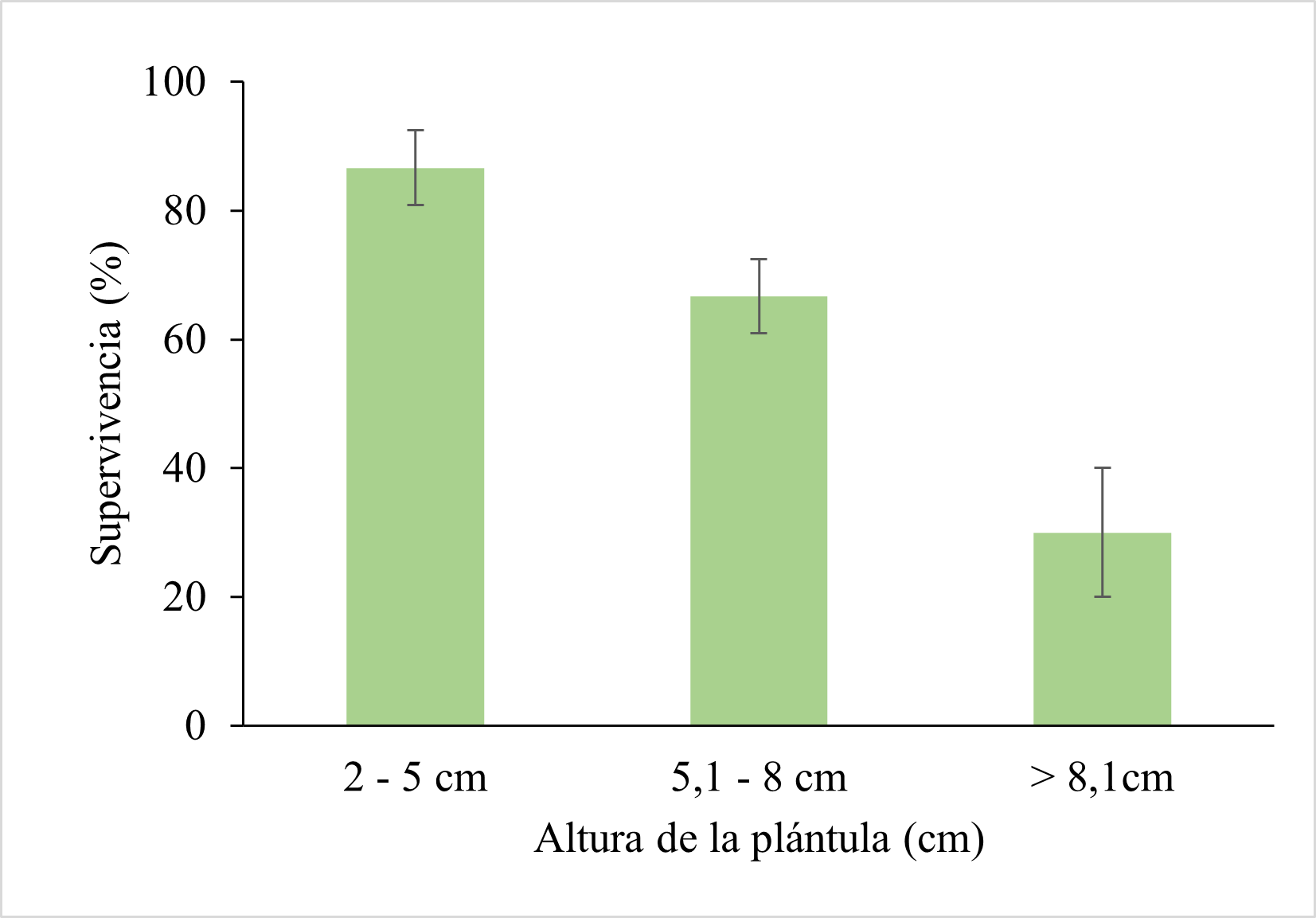Influence of Cinchona officinalis (Rubiaceae) seedling size on survival and stem deformation after replanting
Main Article Content
Abstract
Downloads
Article Details

This work is licensed under a Creative Commons Attribution-NonCommercial 4.0 International License.
References
AYMARD C., G.A., 2019. Breve reseña de los aspectos taxonómicos y nomenclaturales actuales del género Cinchona (Rubiaceae-Cinchoneae). Revista de la Academia Colombiana de Ciencias Exactas, Físicas y Naturales [en línea], vol. 43, no. 1, pp. 234-241. [Consulta: 30 junio 2021]. ISSN 0370-3908. DOI 10.18257/raccefyn.1079. Disponible en: http://www.scielo.org.co/scielo.php?script=sci_abstract&pid=S0370-39082019000500234&lng=en&nrm=iso&tlng=es.
CALEGARI, L., MARTINS, S.V., BUSATO, L.C., SILVA, E., COUTINHO JUNIOR, R. y GLERIANI, J.M., 2011. Produção de mudas de espécies arbóreas nativas em viveiro via resgate de plantas jovens. Revista Árvore [en línea], vol. 35, no. 1, pp. 41-50. [Consulta: 30 junio 2021]. ISSN 0100-6762 . DOI 10.1590/S0100-67622011000100005. Disponible en: https://www.scielo.br/j/rarv/a/TsXR8TZbjLN9bgHY34T4xmP/abstract/?lang=pt.
CRUZ, H. de la, VILCAPOMA, G. y POLLITO, P., 2007. Ethnobotanical study of medicinal plants used by the Andean people of Canta, Lima, Peru. Journal of Ethnopharmacology [en línea], vol. 111, no. 2, pp. 284-294. DOI 10.1016/j.jep.2006.11.018. Disponible en: https://www.researchgate.net/publication/266388116_Ethnobotanical_study_of_medicinal_plants_used_by_the_Andean_people_of_Canta_Lima_Peru.
DUMROESE, R. K., DAVIS, A. S. y JACOBS, D. F. 2011. Nursery response of Acacia koa seedlings to container size, irrigation method, and fertilization rate. Journal of Plant Nutrition [en línea], vol. 34, no. 6, pp. 877-887. [Consulta: 10 agosto 2021]. ISSN: 1532-4087. DOI 10.1080/01904167.2011.544356. Disponible en: https://www.tandfonline.com/doi/abs/10.1080/01904167.2011.544356
FAJARDO, J., LESSMANN, J., BONACCORSO, E., DEVENISH, C. y MUÑOZ, J. 2014. Combined use of systematic conservation planning, species distribution modelling, and connectivity analysis reveals severe conservation gaps in a megadiverse country (Peru). PLoS ONE [en línea], vol. 9, no. 12. [Consulta: 10 agosto 2021]. DOI 10.1371/journal.pone.0114367. Disponible en: https://journals.plos.org/plosone/article?id=10.1371/journal.pone.0114367.
FEREZ, A.P.C., CAMPOE, O.C., MENDES, J.C.T. y STAPE, J.L., 2015. Silvicultural opportunities for increasing carbon stock in restoration of Atlantic forests in Brazil. Forest Ecology and Management [en línea], vol. 350, pp. 40-45. [Consulta: 30 junio 2021]. ISSN 0378-1127. DOI 10.1016/j.foreco.2015.04.015. Disponible en: https://www.sciencedirect.com/science/article/pii/S0378112715002200.
GILMORE, A.M. y GOVINDJEE, 1999. How higher plants respond to excess light: energy dissipation in photosystem II. En: G.S. SINGHAL, G. RENGER, S.K. SOPORY, K.-D. IRRGANG, y GOVINDJEE (eds.), Concepts in Photobiology: Photosynthesis and Photomorphogenesis [en línea]. Dordrecht: Springer Netherlands, pp. 513-548. [Consulta: 30 junio 2021]. ISBN 978-94-011-4832-0. Disponible en: https://link.springer.com/chapter/10.1007/978-94-011-4832-0_16.
HOLDRIDGE, L.R., 1987. Ecología basada en zonas de vida [en línea]. San José, Costa Rica: Instituto Interamericano de Cooperación para la Agricultura (IICA). ISBN 978-92-9039-131-9. Disponible en: https://books.google.com.cu/books?id=m3Vm2TCjM_MC&printsec=frontcover#v=onepage&q&f=false.
HOLL, K.D. y AIDE, T.M., 2011. When and where to actively restore ecosystems? Forest Ecology and Management [en línea], vol. 261, no. 10, pp. 15-58-15-63. [Consulta: 30 junio 2021]. ISSN 0378-1127. DOI 10.1016/j.foreco.2010.07.004. Disponible en: https://www.sciencedirect.com/science/article/pii/S0378112710003750.
HOOGTE, A.R. van der y PIETERS, T., 2015. Science, industry and the colonial state: a shift from a German- to a Dutch-controlled cinchona and quinine cartel (18801920). History and Technology [en línea], vol. 31, no. 1, pp. 2-36. [Consulta: 30 junio 2021]. ISSN 0734-1512. DOI 10.1080/07341512.2015.1068005. Disponible en: https://www.tandfonline.com/doi/abs/10.1080/07341512.2015.1068005?journalCode=ghat20.
HUAMÁN, L., ALBÁN, J. y CHILQUILLO, E., 2019. Aspectos taxonómicos y avances en el conocimiento del estado actual del árbol de la Quina (Cinchona officinalis L.) en el Norte de Perú. Ecología Aplicada [en línea], vol. 18, no. 2, pp. 145-153. [Consulta: 30 junio 2021]. ISSN 1726-2216. DOI 10.21704/rea.v18i2.1333. Disponible en: http://www.scielo.org.pe/scielo.php?script=sci_abstract&pid=S1726-22162019000200005&lng=es&nrm=iso&tlng=es.
KITAO, M., LEI, T.T., KOIKE, T., TOBITA, H., MARUYAMA, Y., MATSUMOTO, Y. y ANG, L.-H., 2000. Temperature response and photoinhibition investigated by chlorophyll fluorescence measurements for four distinct species of dipterocarp trees. Physiologia Plantarum [en línea], vol. 109, no. 3, pp. 284-290. [Consulta: 30 junio 2021]. ISSN 1399-3054. DOI https://doi.org/10.1034/j.1399-3054.2000.100309.x. Disponible en: https://onlinelibrary.wiley.com/doi/abs/10.1034/j.1399-3054.2000.100309.x.
LOAYZA-O, K., DE OLIVEIRA, B.H., CÓNDOR, C.E. y REYNA, P.V. 2010. Estudio químico de los tallos de Cinchona pubescens. Revista de la Sociedad Química del Perú [en línea], vol. 7, no. 1, pp. 10-24. [Consulta: 10 agosto 2021]. ISSN 1810-634X. Disponible en: http://www.scielo.org.pe/pdf/rsqp/v75n1/a08v75n1.pdf
LOPEZ, N., 2016. Evaluación del paisaje y recursos escénicos después de 350 años de explotación de la "cascarilla" o "quina" Cinchona officinalis L. (Rubiaceae) en el sector Cajanuma-Rumishitana, Ecuador. Arnaldoa [en línea], vol. 23, no. 2, pp. 461-474. DOI 10.22497/arnaldoa.232.23205. Disponible en: https://www.researchgate.net/publication/311646129_Evaluacion_del_paisaje_y_recursos_escenicos_despues_de_350_anos_de_explotacion_de_la_cascarilla_o_quina_Cinchona_officinalis_L_Rubiaceae_en_el_sector_Cajanuma -Rumishitana_Ecuador.
LÜTTGE, U., 2008. Physiological Ecology of Tropical Plants [en línea]. 2. Berlin Heidelberg: Springer-Verlag. [Consulta: 30 junio 2021]. ISBN 978-3-540-71792-8. Disponible en: https://www.springer.com/gp/book/9783540717928.
POORTER, H., BÜHLER, J., VAN DUSSCHOTEN, D., CLIMENT, J. y POSTMA, J.A. 2012. Pot size matters: a meta-analysis of the effects of rooting volume on plant growth. Functional Plant Biology [en línea], vol. 39, no. 11, pp. 839-850. [Consulta: 10 agosto 2021]. ISSN: 1445-4408. DOI 10.1071/FP12049. Disponible en: https://www.publish.csiro.au/FP/fp12049
SOUTH, D.B., HARRIS, S.W., BARNETT, J.P., HAINDS, M.J., y GJERSTAD, D.H. 2005. Effect of container type and seedling size on survival and early height growth of Pinus palustris seedlings in Alabama, USA. Forest Ecology and Management [en línea], vol. 204, no. 2-3, pp. 385-398. [Consulta: 10 agosto 2021]. ISSN 0378-1127. DOI 10.1016/j.foreco.2004.09.016. Disponible en: https://www.sciencedirect.com/science/article/pii /S0378112704006929?casa_token=XwFj2Vxow2AAAAAA:uCHbMNqw9xBbw8aOPLvip8cvPPhGVxGHG25ddYCfBfVRPoEwQvA2Tw5nFkAOM0OydxF5Ve_dxldG
TAIZ, L. y ZEIGER, E., 2009. Fisiología vegetal. 4ta. Porto Alegre, Brasil: Artmed.
TURCHETTO, F., ARAUJO, M., TABALDI, L., GRIEBELER, A., RORATO, D., AIMI, S., BERGHETTI, A. y RODRIGUES GOMES, D., 2016. Can transplantation of forest seedlings be a strategy to enrich seedling production in plant nurseries? Forest Ecology and Management [en línea], vol. 375, pp. 96-104. DOI 10.1016/j.foreco.2016.05.029. Disponible en: https://www.researchgate.net/publication/303558807_Can_transplantation_of_forest_seedlings_be_a_strategy_to_enrich_seedling_production_in_plant_nurseries.
VIANI, R.A.G. y RODRIGUES, R.R., 2007. Sobrevivência em viveiro de mudas de espécies nativas retiradas da regeneração natural de remanescente florestal. Pesquisa Agropecuária Brasileira [en línea], vol. 42, no. 8, pp. 1067-1075. [Consulta: 30 junio 2021]. ISSN 0100-204X. DOI 10.1590/S0100-204X2007000800002. Disponible en: https://www.scielo.br/j/pab/a/BJXSGzFxTTMNbXLnDJDVm9j/abstract/?lang=pt.
ZEVALLOS POLLITO, P.A., 1989. Taxonomía, distribución geográfica y status del genero cinchona en el Perú. Agris [en línea], [Consulta: 23 marzo 2020]. Disponible en: http://agris.fao.org/agris-search/search.do?recordID=PE1989102947.


